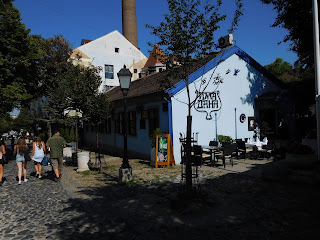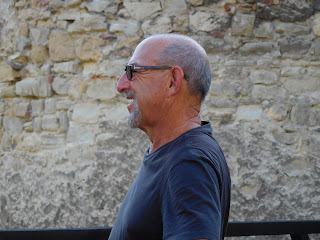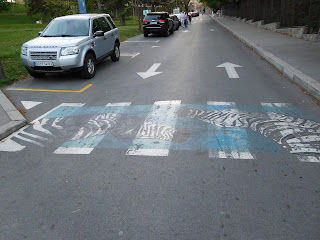After a fun few days in Ljubljana ,
we were off to discover another city in the Balkans: Belgrade ,
the capital of Serbia ,
courtesy of Air Serbia .
I had last been back here in the summer of 1974 while living for a year as an
au pair for a Canadian diplomatic family in Geneva .
They had returned to see friends whom they had known when they were previously
posted to Belgrade . Everything had
changed so much I had no memories of my brief stay from over four decades ago.
Our hostel in Belgrade .
Not too shabby, huh! We didn’t realize until later that there were only two
toilets and two showers for about 20 people. The toilet in one bathroom had no seat and
the other bathroom had no lock! Can’t expect too much, right!
I felt badly for the people in the adjoining dorm room as we had to enter and leave through their room to get to ours.The view from our balcony!
After checking in and dumping our bags, we decided to go for
a walk and explore some of the city as it was only about 1:30 by then.
The city’s only pedestrian street, Knez
Mihsilova Street,
Scenes from the pedestrian mall:
Scenes from the pedestrian mall:
After getting a map from the tourist information bureau on
the mall, we strolled over to the Bohemian Quarter called Skadarska. There were
scads of restaurants and bars there but few galleries and shops which we were expecting.
Musicians serenading restaurant patrons:
Interesting story:
The Fountain of Skardaska:
In front of the Casablanca Bar, there were lots of men
drinking beer and watching with delight at the football game on the outdoor TV. We would have called it soccer but, outside the US
and Canada , the
game is only known as football.
We slowly made our way over to Republic Square to wait for the
Belgrade Free Walking Tour to begin as we normally enjoy them so much when we visit a new
city
The photo below was of the top a building near the square. I had to use the zoom lens to get the shot as it was so far away.
Our walking tour guide, Jovana, said that Republic Square is a great meeting place in the city as everything starts here including political demonstrations, marathons, etc. The photo below was of the top a building near the square. I had to use the zoom lens to get the shot as it was so far away.
The focal point of the square is a monument of Prince Michael who is considered so
important in Belgrade Serbia
Prince Michael developed both the National
Museum
The National Museum:
That went for several years until finally there was a countdown clock which indicated it would open in 745 (I think that was the number Jovana mentioned!) days. The clock counted down until it reached 52 days and then it miraculously broke. Since then, there has never been any new information as to when it will open now.The 'broken' countdown clock:
The National Theater:
We walked back over to Skadarska aka Skadarlija. During the
19th century, no one wanted to live in the district which is often compared to
the Montmartre of Paris, Jovana said. Artists though did move in. She pointed
out caffanas, places some of the people on the tour might want to eat at later.
They are great for a family lunch, a business lunch or even a romantic rendez-vous.
She said the worse the place looks, the better it is!
She showed us the sign listing a variety of directions, one
of them pointing up to the moon. That’s for those people who have drunk so
much, they then fall down and don’t know which direction is up!
Jovana had brought along a small bottle of a drink, rakja,
which is much loved by people all over the Balkans. She gave everyone a small
shot of it. She joked you can start the day with it, use it if you have a
toothache, use it to celebrate any occasion or use it if you have a cough, i.e.
perfect for all occasions!
Jovana talked about all the musicians in the bars and
restaurants. They will come up to people sitting in the restaurant, get in
their faces and ask, “What song does your heart want to hear?” It’s sort of
like a jukebox as Jovana joked! People are then expected to put money in the
bowl part of the trumpet or in the accordion. Another option is to put a
banknote on the musician’s sweaty forehead. If it stays there for the duration
of the song, the musicians are not playing enthusiastically enough. Of course,
the bills fall off every time!
We followed her then toward Belgrade ’s
Old Town
As Jovana said, we were all taught in our history books that WWI was started in Sarajevo when Archduke Franz Ferdinand was killed by Gavrilo Princip, a Serbian. He is actually considered a hero in Belgrade because Serbia was always part of the Austro-Hungarian Empire and he and others wanted Serbia to be independent from the Empire. The first shots fired in WWI were in Belgrade.
During WWI, thirty percent of the Serbian population or 1.3
million people, died. They didn’t die on the battlefield but of cold and
famine, Jovana related. That was more per capita than any other country in the war, she stated.
I felt quite ignorant as I was totally unaware of the magnitude of the first world war on
the Serbian people.
Some fascinating street art:
Wonder who this is?
Jovana said that Yugoslavia
means South Slavs and all the people that comprised Yugoslavia
at the end of WWII did so in part because of their having a common language.
Many people mistakenly think that Albanians are also Slavs; however Albania is only
a neighboring country.
We walked next throught the Dorcol neighborhood of Belgrade. During Austrian rule, this area was called the Danube Town. Jovana pointed out the oldest residential house in Belgrade which was a Turkish house which had belonged to a rich Turkish family
until it became a school.
Bajrakli Mosque and the Sheikh Mustafa Tomb in Dorcol:
Jovana mentioned that there are 30 letters and, more importantly, only 30 sounds in the Cyrillic alphabet which originated in Bulgaria and is the script used in Serbia. Think how English would be if there were only one sound associated with each letter!
She said that kids growing up are so exposed to the Latin
script in everything they see on TV and do online, etc that it has become a
significant problem for young people growing up in Serbia
Jovana said everyone knows the word ‘vampire’ but probably
never knew the word is actually Serbian. To Serbs, it means a creepy creature.
They often explain away things they don’t understand as being vampires or
creepy creatures.
On the way to our next stop, I couldn’t help but stop and
admire a really neat playground that had a soft surfacing called ‘poured in
place.’ Just before we left Denver
in mid August, I had been very involved in helping to build a new, handicapped
accessible playground in our neighborhood.
As a result, I look at playgrounds in other cities and countries with a deeper appreciation than most tourists, I am sure!
Walls of Kalmedegan or Fortress:
It was so strange seeing this stretch limo with the Florida
license plates of all things just outside the fortress walls.
Jovana explained what a great strategic location Belgrade is compared to so many other cities in Europe. There were 114 battles (remember that number for later!) waged in the city and the city was completely destroyed 44 times. I cannot begin to fathom rebuilding so many times after so much destruction.
Entering the Austrian Gate (I think) of the Fortress:
I love this photo of Steven especially as he had no idea I was taking it.
Now the presence of the limo made sense!
The fortress is considered to be the museum of Belgrade history and to have one of the most beautiful outlooks in Europe. Certainly hard to dispute that when we saw the view in front of us with the confluence of the Danube and Sava rivers before our eyes.
There is also a large island right in the middle of the confluence of those rivers. Many battles were waged on
that island that once belonged to the Austro-Hungarian Empire. It was
interesting to learn that the island is always three degrees Celsius there
both winter and summer. There is a residential area on the island called Zemun
that only recently merged with Belgrade .
Jovana mentioned how she and so many of her friends liked to
play right at this spot on this hill at the Fortress in the snow when they were
young. Residents only found out in 2008 that a military bunker had been placed
right there in 1948 and that was the cause of the hill!
The temperature in the bunker is kept at a constant
temperature of 11-12 degrees Celsius and is open for tours, she said. Somehow being
underground once again did not appeal to us quite so soon after visiting the Postonja
Caves Bosnia Herzegovina.
Just beyond 'Jovana's snow hill' was a statue of a naked man representing Victory in the first
Balkan War: The man was intentionally
left naked so that no one side could take umbrage if he had been wearing a uniform
favored by one side. The rifle is in the down position which indicated, Jovana
said, he came in peace.
The sculpture had formerly been placed right in front of Hotel Moscow, a major hotel downtown, but hotel patrons took offense at the frontal views so it was moved.
A better view of his rifle.
Jovana only talked briefly about the Serbian wars of the
90s. She purposely chose not to dwell on that part of her country’s history
saying she wanted the tour’s participants to come away with positive memories
of her city. I am so glad, though, she did speak about her family’s experiences
during that dark period so that we would gain a better understanding of the
war’s impact on one family.
In 1993, the hyperinflation in Belgrade
was the worst in the world up until what is happening now in Zimbabwe ,
Jovana said. (I felt so ignorant as she said this because I was/am totally
unaware of that country’s current fiscal crisis and we are going to be there
briefly in a few months’ time as part of this trip.) She recounted a story of a
doctor who had delayed spending her monthly paycheck by one day. That meant her salary wasn't even enough to pay for a newspaper or a cup of coffee.
Jovana recounted how friends would go out for a cup of
coffee and, by the time it was finished three hours later, another cup of coffee
was three times higher.
The war started in 1991 in Slovenia Croatia
Her family were billionaires just like Bill Gates, she
joked. However, her family’s 500 billion was only enough to live on for a few
days.
A 500 billion banknote:
As part of the war, that began four years later in early 1998, between the
combined forces of Serbia
and Montenegro (the
only remaining countries in Yugoslavia )
against Kosovo, NATO forces started bombing military bases and radio and TV
stations in Belgrade . They also
announced the plan and the timeline when they were going to blow up the
strategic bridge below. To try and stop that from happening, many people started to
print targets or bulls eyes on their shirts and then congregated on the bridge.
Concerts were organized that also took place on the bridge so that bombing could
not occur. The people’s goals were accomplished and the bridge was never
bombed.
Jovana had been, without a doubt, the best walking tour
guide we’ve ever had and we’ve been on walking tours in so many cities around
the world. She brought the city’s history to life and was even able to
bring a sense of humor to the travails of war. Everyone on the tour appreciated
the free shot of ‘medicinal’ rakja near the beginning of the tour and how she had
free postcards and even a copy of a billion banknote.
Then, at the end of the 2.5
hour tour, there was a pop quiz. Jovana asked everyone who had remembered how many
battles Belgrade had been involved
in. I was the only one to pipe in with the correct number of 114. People joked that I
could only remember that because I had been writing notes the whole time!
Steven had thought she had said 140 as his hearing is off. My/our prize was the
small, empty sample bottle of rakja. I was thrilled as that was about the only
time I had won anything. Nina: You would have been so proud of me as I know how
good you are at winning prizes!
When the walking tour ended at 6:30 , we headed over to Ruzica Church, which was also located in the Fortress. On the way we stopped at a couple of other sights.
Wish I knew the meaning of this sculpture we saw in the park.
Still more of the Fortress walls:
Our first view of Ruzica Church was the spire peeking out over the walls:
Photos of Ruzica Church:
It was very eerie seeing the chandeliers made of bullets:
Steven and I remarked that we had never seen votive candles outside a church before.
Just a couple of minutes away was Petke
Church
We exited Kalmedgan Fortress by the city zoo. Fun to see a real
‘zebra crossing’ aka pedestrian crossing in this spot. I think that’s the only one I’ve ever seen like
this.
The pedestrian street was hopping that night, just packed
with wall to wall people. We found another restaurant, also near the hostel, and collapsed in it at 8:30. We would have liked to eat outside but virtually everyone outside was smoking and the only two tables inside were reserved for non-smokers. We felt like pariahs this time, not like the smokers in the US and Canada!
About the only thing I can think of right now that makes traveling in Europe and many parts of Asia tough is the preponderance of people, especially young people, who smoke. I hate to think what the cancer rates are and will be in so many nations due to cigarette smoke and also second-hand smoke. That's my soapbox moment for the day.
To get up to our hostel on the third floor, we took this
positively ancient elevator, just like the one you see in the movies about a
bygone age. As it very slowly made its way up two flights, creaking every
moment of the way, I admit to sort of wondering if we’d make it up in one
piece. As tired as we were though, since we had started the day in Ljubljana, we had no intention of walking up the stairs!
Good night and sweet dreams wherever you are!







































































No comments:
Post a Comment
We love to hear from you!!!!